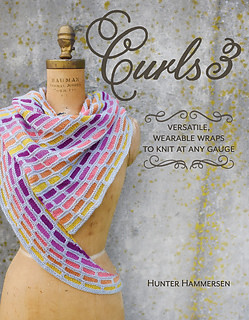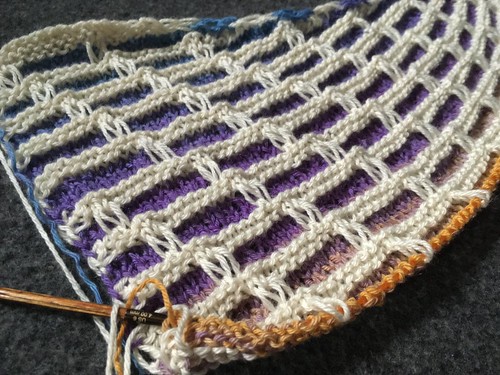Hunter Hammersen does it again! In Curls 3, you'll find 11 new designs that were created specifically for speckled and gradient yarns. Of course, they can also be knit with any other type of yarn you desire - and just as in the first two Curls books (Curls and Curls 2), you also aren't limited by yarn weight, because each design can be knit at any gauge.
Each shawl is knit with the same formula, which is described in depth in the Anatomy of a Curl section at the start of the book. Once you are familiar with the basic setup, you can easily follow the color coded charts and schematics as you knit your chosen pattern (all of which are explained clearly in this section of the book). If you's someone who likes to modify patterns here and there, make sure not to skip this section!
Also worth a read is the section on Speckles and Gradients, which is also found at the start of the book. Hunter clearly defines each type of yarn and shares a lot of great tips for choosing and working with these beautiful and tempting colors, which can sometimes be a challenge once you start to knit with them.
The patterns are grouped by the type of yarn they were designed for, beginning with speckles (the first four designs) and then continuing with single-skein gradients (the next 2) and multi-skein gradients (the final 5) - but that is only a guideline, and substitutions are strongly encouraged!
I took that note to heart when deciding to cast on for the cover project with a single-skein gradient of Lhasa Wilderness yarn (a test dye lot from ModeKnit Yarn) and paired it with an undyed skein of the same yarn base. Cacoxenite is actually written for a multi-skein gradient set, but as you can see, the pattern works just as beautifully with a single-skein gradient:
Hunter was sweet enough to send me an extra copy of this book, so I'll be giving it away with some lovely hand-dyed yarn today over on my Instagram feed - click here to make sure you follow me so you don't miss my post!
Each shawl is knit with the same formula, which is described in depth in the Anatomy of a Curl section at the start of the book. Once you are familiar with the basic setup, you can easily follow the color coded charts and schematics as you knit your chosen pattern (all of which are explained clearly in this section of the book). If you's someone who likes to modify patterns here and there, make sure not to skip this section!
Also worth a read is the section on Speckles and Gradients, which is also found at the start of the book. Hunter clearly defines each type of yarn and shares a lot of great tips for choosing and working with these beautiful and tempting colors, which can sometimes be a challenge once you start to knit with them.
The patterns are grouped by the type of yarn they were designed for, beginning with speckles (the first four designs) and then continuing with single-skein gradients (the next 2) and multi-skein gradients (the final 5) - but that is only a guideline, and substitutions are strongly encouraged!
I took that note to heart when deciding to cast on for the cover project with a single-skein gradient of Lhasa Wilderness yarn (a test dye lot from ModeKnit Yarn) and paired it with an undyed skein of the same yarn base. Cacoxenite is actually written for a multi-skein gradient set, but as you can see, the pattern works just as beautifully with a single-skein gradient:




Hunter is the most amazing designer.
ReplyDelete